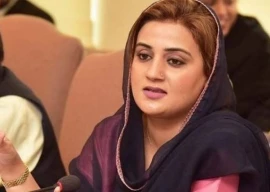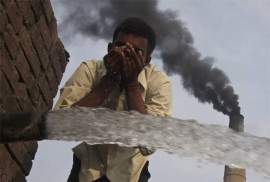
Her doctor recommends she should improve her diet by including fresh milk, fruits, vegetables, eggs and chicken, to deliver her third son.
Contrary to popular belief, this is not good news for Naeema.
“I am anaemic, and my other two children are under-weight. We cannot afford a healthy meal. How can I be happy about a third malnourished offspring?” asked a not-so-enthusiastic Naeema.
“My husband is a security guard and his monthly income is Rs10,000. Health, for us, is a luxury.”
Like Naeema, many in Pakistan suffer from chronic malnutrition. According to the World Bank, currently half of the country’s women and children are malnourished. The authorities have termed the situation worse than that of countries in sub-Saharan Africa.
“On the one side, people are victims of terrorism, and on the other there are victims of chronic malnutrition. Sadly, the government is not paying much heed to the issue,” a senior government official, who earlier served in the health ministry, t0ld The Express Tribune.
“In the future, I see malnourished children as a burden on the country’s economy.”
He blamed lack of political commitment, accountability and awareness as the key reasons behind the health disorder. Party manifestoes, he said, failed to address malnutrition and how it could be countered.
Financial respite to Sindh
Laila Rubab, advocacy liaison project manager at Save The Children, Karachi, said the government is committed to overcome the malnutrition problem but lacks technical and financial resources.
Thereby, with the support of European Union (EU), Save the Children, ACF International and MERLIN, a programme called Women and Infant Nutrition in Sindh (WINS) has been launched to tackle malnutrition and food insecurity in Sindh and southern Pakistan.
The EU granted €30 million on Monday to the three organisations to work directly with the local government, partner organisations and communities to strengthen their capacity to respond to the nutrition crisis and improve feeding practices among women and children.
WINS focuses on improving nutritional status of more than 1,777,372 children and women in Shikarpur, Dadu and Thatta districts.
“This is going to be a pilot project and if the turnout in Sindh is successful it will be launched in other parts of the country as well,” Rubab said.
According to the 2011 National Nutrition Survey (NNS) compiled by the health ministry, 17.5% of children under the age of 5 are wasted, due to acute malnutrition, and nearly 7% of these are severely wasted.
Half of the children in Sindh are stunted making them more vulnerable to diseases – which impair their intellectual and physical development in the long run.
“The devastating floods are one of the major causes behind the chronic malnutrition in the region. Due to water logging, crops cannot be grown,” she said.
Country director at Save the Children Efforts David Skinner said the programme will ensure nutrition and food security are addressed in the Medium Term Development Framework (MTDF) for Sindh, in line with the government’s commitment to meeting the Millennium Development Goals by 2015.






1732705646-0/BeFunk_§_]__-(62)1732705646-0.jpg)
1732699900-0/BeFunk_§_]__-(60)1732699900-0.jpg)

1732697578-0/Untitled-design-(5)1732697578-0-270x192.webp)







COMMENTS
Comments are moderated and generally will be posted if they are on-topic and not abusive.
For more information, please see our Comments FAQ